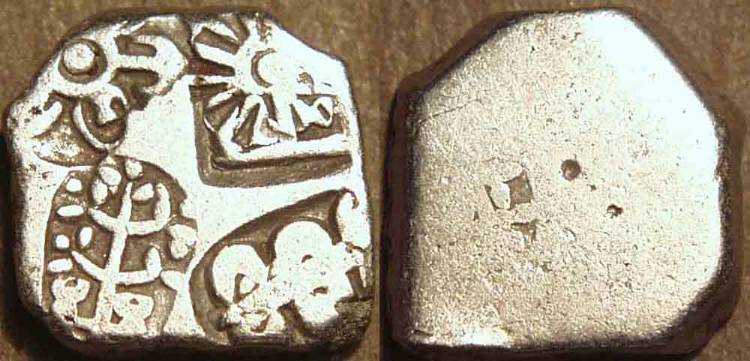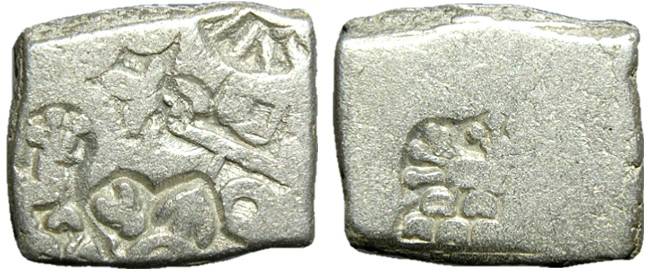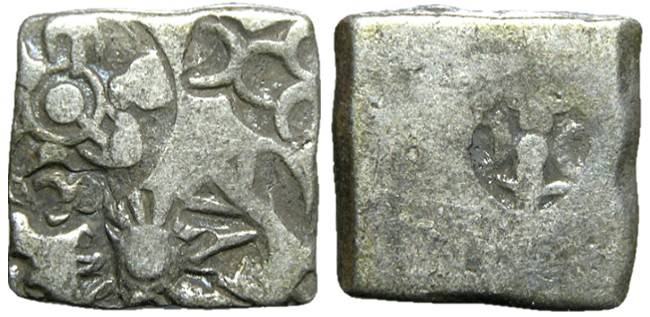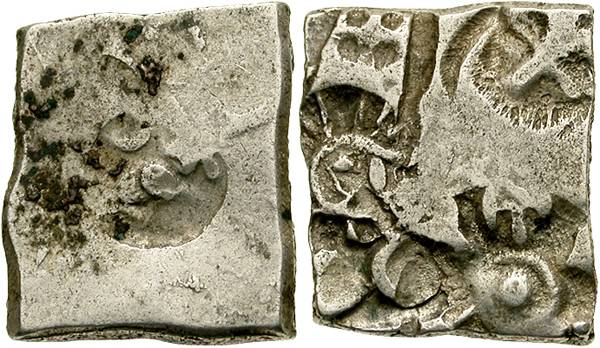

A Mauryan silver karshapana; it may or may not be one of the earliest issue, c.320-270
Source:
http://www.vcoins.com/ancient/coinindia/store/viewitem.asp?idProduct=109
(downloaded May 2007)
"MAURYA: Series Va punchmarked silver karshapana. Obverse: Five official punches. Reverse: Trace of one unofficial banker's mark. Date: c. 4th-3rd century BCE. Weight 3.14 gm. Dimensions: 13 x 13 mm. Comments According to Gupta and Hardaker, the Series Va coins are the initial issues of the growing Maurya empire. They date these coins to c. 320-270 BCE, the time of Chandragupta Maurya and Bindusara."

A typical Mauryan silver karshapana; these coins may or may not be assignable, on the basis of their designs, to different rulers
Source:
http://www.vcoins.com/ancient/dltcoins/store/viewitem.asp?idProduct=1521
(downloaded May 2007)
"India, Mauryan Empire; AR Karshapana, c.321-187 BC. Mint
(Pataliputra
?). Obverse Five punches: stupa/ peacock-on-hill/ balance + sun
&
6-armed symbol. Reverse Peacock-on-hill. Weight 3.23gm
Diameter
14x12mm "
[Image and description courtesy of *David
L. Tranbarger Rare Coins*.]

Another example of a Mauryan silver karshapana
Source:
http://www.vcoins.com/ancient/dltcoins/store/viewitem.asp?idProduct=1540
(downloaded May 2007)
"Mauryan Empire, AR Karshapana, c. 321-187 BC. Mint: (Pataliputra
?).
Obverse: Five punches: stupa/ tree-in-railing/ bull + sun & 6-armed
symbol. Reverse: Septa-radiate symbol. Weight 3.37gm. Diameter 14x13mm
square. Reference MACW 4195-4196; attributed to Samprati,
216-207
BC. Mitchiner, in his Oriental Coins and their Values: The Ancient and
Classical World (MACW) attributes various sets of marks to specific
Mauryan
rulers. His attribution is given above. Mitchiner's attributions,
however,
are not widely accepted and most scholars in the field do not believe
that
the current state of knowledge is sufficient to assign these coins to
specific
rulers."
[Image and description courtesy of *David
L. Tranbarger Rare Coins*.]


Three Ashokan (?) coins, and an analysis that shows how the tentative identifications are made
Three different silver Karshapanas, measuring (from left to right) 13 mm, 15 mm and 15 mm.
Each coin has on the obverse five individual punches:
All Mauryan silver karshapanas show the first two symbols, the sun and some form of the six-armed symbol. The third symbol, the "hills", is thought the indicate the main mint at the time of Asoka. The fourth symbol, composed of six semi-circles, is thought to represent the regal symbol of Asoka. The fifth symbol is variable and may indicate a particular coinage issue.Source of coins and interpretive commentary both: http://members.aol.com/dkaplan888/asok.htm

A contemporary coin of the city-state Tripuri, with a legend in Ashokan Brahmi
Source:
http://www.vcoins.com/ancient/coinindia/store/viewitem.asp?idProduct=807
(downloaded Apr. 2008)
"INDIA, ANCIENT CITY-STATES, TRIPURI. Potin uniface karshapana. Very rare. Obverse: Hollow cross at top right, chaitya, or crescented three-arch hill, below, legend in Ashokan Brahmi at left: Tipuri. Reverse: Blank. Date c. 3rd century BCE. Weight 6.91 gm. Diameter 19-20 mm."
== Indian Routes index == Indian Routes sitemap == Glossary == FWP's main page ==